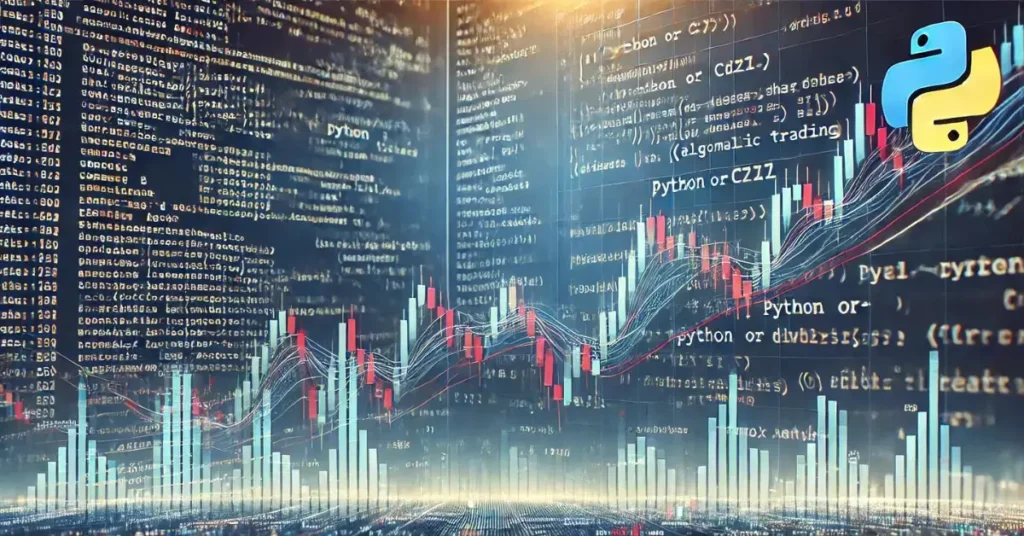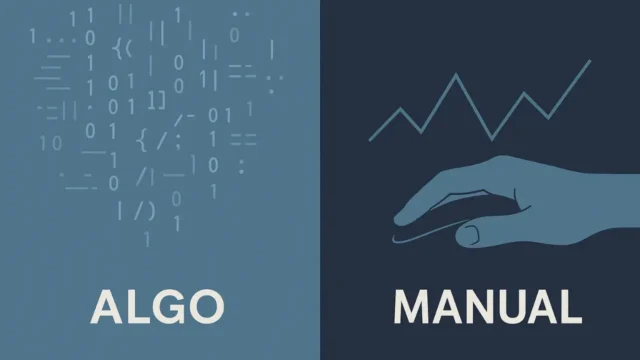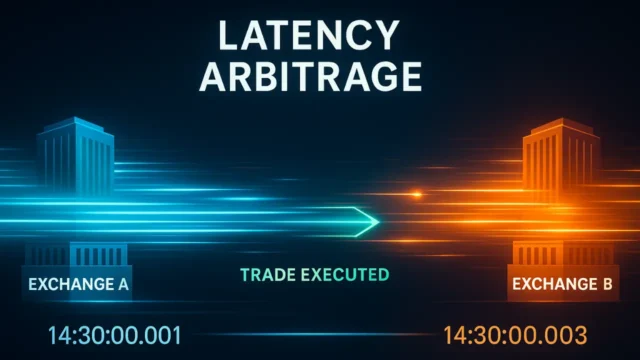Follow Us
Basics of Algorithmic Trading : A Helpful Beginner’s Guide

Table of Contents
Algorithmic trading now accounts for over 60% to 73% of all U.S equity trading market, transforming how both retail and institutional investors engage with the markets.
Imagine this, your trade gets executed in less time than it takes to blink. That’s the kind of speed algorithmic trading brings to the table.
In a fast-moving market, every millisecond counts, and that’s where algorithms shine. They operate without hesitation, following predefined instructions and cutting out the guesswork.
So, what exactly is algorithmic trading? At its core, it’s the use of computers to automate the buying and selling of financial assets.
Instead of relying on human intuition, algorithms use data, lots of it – to make decisions. This approach isn’t just about speed; it’s about precision.
It allows traders to avoid the emotional pitfalls that come with manual trading, making decisions based purely on numbers and logic.
What is Algorithmic Trading?
Let’s break it down simply – algorithmic trading is about using computers to automate your trading decisions.
Instead of manually placing trades based on your gut or market sentiment, you set up an algorithm (a series of rules) to make trades for you. These rules could be based on timing, price, quantity or any other market condition.
For example, you might tell the algorithm, “Buy 100 shares of XYZ stock when its price drops below $50.” Once that condition is met, the algorithm executes the trade instantly, without you having to lift a finger.
This is the power of automation – no emotions, just precise execution.
Key Terminology:
Let’s get a few essential terms clear:
- Algorithm: This is simply a set of predefined rules or instructions. In trading, it could be something like, “Buy when the price goes below this level and sell when it goes above that level.”
- Trading Bots: These are the programs that follow the algorithm’s instructions to execute trades. They monitor the market 24/7 and act the moment conditions align with the rules you’ve set.
- High-Frequency Trading (HFT): This is a more extreme version of algorithmic trading, where thousands of trades are executed in milliseconds. HFT firms use advanced algorithms to take advantage of even the tiniest market inefficiencies.
Types of Algorithmic Trading
1. Arbitrage:
This strategy involves buying and selling the same asset in different markets to profit from price differences. Imagine stock XYZ trading at $50 on one exchange and $50.10 on another.
An algorithm could instantly buy on the cheaper exchange and sell on the more expensive one, pocketing the difference. With speed being crucial here, algorithms outperform humans easily.
2. Trend-Following Strategies:
As the name suggests, this strategy aims to capitalize on market trends. Algorithms track the market’s momentum and execute trades in the direction of the trend.
If a stock price is climbing steadily, the algorithm buys in, riding the wave until the trend reverses. It’s simple, but effective.
3. Market-Making:
This involves placing buy and sell orders for the same asset to profit from the bid-ask spread. Market makers provide liquidity to the markets.
Algorithms can automate this process, constantly adjusting the prices they quote based on market conditions, ensuring profitability from tiny price gaps.
4. Statistical Arbitrage:
This is a more complex strategy, involving statistical models to identify mispriced assets. The algorithm looks for price deviations from historical norms and exploits these inconsistencies.
It’s a data-driven approach, relying heavily on math and historical data to make trading decisions.
The Role of Data in Algorithmic Trading
Data is the backbone of algorithmic trading – without it, algorithms are flying blind. Algorithms rely on a constant stream of market data (like price movements, trading volume, and volatility) to make informed decisions.
For instance, a trend-following algorithm needs price data to recognize patterns, while an arbitrage strategy needs real-time data from multiple exchanges to spot pricing differences.
Beyond real-time data, technical indicators like moving averages, relative strength index (RSI), and Bollinger Bands are used to refine strategies. These indicators help algorithms make more calculated decisions, whether it’s entering or exiting a trade or setting stop-loss limits.
In short, data is what drives algorithmic trading, it’s what gives the algorithm the intelligence to act quickly and efficiently in a way that human traders simply can’t match. The more accurate and timely the data, the better the performance of the algorithm.
Why Algorithmic Trading is Revolutionizing Markets
Algorithmic trading isn’t just a new trend, it’s changing the way the markets work entirely. Let’s break down why this shift is so significant.
Speed & Efficiency
The first major advantage of algorithmic trading is its speed. Humans can’t react to market changes in milliseconds, but algorithms can. They execute trades in real-time, the moment the right conditions are met.
Imagine having the ability to react instantly to a price drop or a spike, without any hesitation. Algorithms don’t get tired, they don’t panic, and they don’t suffer from emotional bias. This leads to more consistent results and fewer missed opportunities.
I’ve seen traders struggle with emotions like fear or greed, especially when markets are volatile. Algorithms, however, follow their instructions without wavering.
The result? More efficient trading with fewer errors caused by human psychology.
Accuracy & Precision
Another huge advantage of algorithms is their precision. When you’re trading manually, even experienced traders can make mistakes – like entering the wrong trade size or missing a key exit point.
With algorithmic trading, you can set specific parameters, and the system follows them to the letter.
But the real magic happens with back-testing. Before you ever put your algorithm live in the market, you can test it against historical data to see how it would have performed.
This means you aren’t just guessing, you’re basing decisions on actual results. It’s the difference between calculated, data-backed decisions and gut-feeling trades.
Cost Savings
Let’s be honest, every trade comes with costs. Whether it’s transaction fees or the spread between buying and selling prices, these can add up.
The beauty of algorithmic trading is that it can help reduce these costs. By automating thousands of small, efficient trades, algorithms can avoid the large, costly trades that humans often make in a rush.
Additionally, algorithms are more efficient at optimizing execution. They can break large trades into smaller parts, minimizing the market impact and getting you a better average price. This means lower transaction costs and improved market efficiency overall.
In the long run, algorithmic trading doesn’t just help traders make better decisions—it helps them make more profitable ones by eliminating human error, improving execution, and cutting down on costs.
Essential Components of an Algorithmic Trading System
Building a solid algorithmic trading system isn’t just about writing code and hoping for the best.
It involves a careful process that ensures your strategy not only works in theory but also in practice. Let’s break down the key components that make up an effective system.
Algorithm Design
At the heart of any algorithmic trading system is the algorithm design itself. This is where you, the trader, define the specific rules that the algorithm will follow.
It all starts with deciding on the market conditions that will trigger your trades, your entry and exit points.
For example, you might design an algorithm that buys a stock when its price dips below a 50-day moving average and sells when it crosses above a 200-day moving average.
Or you might incorporate risk management rules, like automatically selling off a position if the price drops by 2% to prevent further losses.
Crafting these rules requires a deep understanding of how markets work and a solid grasp of risk management. If you don’t account for potential risks, even the best algorithm could wipe out your account in a bad market.
Backtesting
Once your algorithm is designed, you don’t just jump into live trading. Instead, you backtest it using historical data.
This means running your algorithm on past market data to see how it would have performed. Would it have made a profit, or would it have led to losses?
Backtesting is crucial because it lets you test your ideas without risking real money. You can tweak your strategy based on its past performance, ensuring it’s robust enough to handle different market conditions.
However, be cautious of overfitting, which is when your algorithm performs exceptionally well in historical tests but fails in live markets because it’s too tailored to past data.
Execution
Execution is how your algorithm turns those rules into real trades. This is where speed and precision come into play. When your algorithm decides to place a trade, it sends an order to the market through a broker’s platform.
But here’s the thing: not all trades happen immediately, especially in volatile markets. Algorithms help by breaking larger orders into smaller chunks to avoid moving the market too much, a practice known as order slicing.
This ensures your trades are executed at the best possible price, without causing price fluctuations that could work against you.
Monitoring & Adjusting
Even the most well-designed algorithm isn’t a “set it and forget it” system. Markets are dynamic, and your strategy may need adjustments as conditions change. That’s why continuous monitoring is essential.
You need to keep an eye on your algorithm’s performance to ensure it’s executing as expected. If the algorithm starts showing unexpected behavior or losing consistently, it’s time to adjust the parameters. This might mean tweaking your entry and exit points or even incorporating new data to adapt to changing market conditions.
In short, a successful algorithmic trading system isn’t just about building an algorithm and letting it run. It’s a constant process of design, testing, execution, and monitoring to stay ahead in the ever-changing market landscape.
Popular Algorithmic Trading Strategies for Beginners
Below are a few popular strategies that are beginner-friendly:
Moving Average Crossover
The moving average crossover is a classic trend-following strategy. It’s simple, straightforward, and works well for beginners. Here’s how it works:
You track two moving averages, a short-term one and a long-term one.
The idea is that when the short-term moving average (e.g., 50-day) crosses above the long-term moving average (e.g., 200-day), it’s a signal to buy because it suggests a new uptrend.
When the short-term moving average crosses below the long-term one, it’s a signal to sell because it indicates a downtrend.
Mean Reversion
Mean reversion works on the assumption that prices will eventually return to their historical average, or “mean.” This strategy is based on the idea that assets can only stray so far from their average price before returning to it.
For example, if a stock price shoots up far beyond its historical average, a mean reversion algorithm might signal a sell, assuming the price will fall back down.
On the flip side, if the price drops too much below the average, the algorithm could trigger a buy, betting that it will revert to its mean.
Arbitrage Opportunities
Arbitrage is one of the oldest tricks in the trading book. Arbitrage opportunities occur when an asset is priced differently in two markets. Algorithms scan for these price differences and execute trades to exploit the gaps.
For example, imagine a stock is trading for $100 on one exchange and $101 on another. An algorithm could instantly buy the stock at $100 and sell it at $101, locking in a quick profit.
The trick here is speed – these price differences can disappear within seconds, so manual trading just doesn’t cut it. Algorithms, however, can react instantly and profit from these fleeting opportunities.
This strategy is especially useful in highly liquid markets where prices shift quickly, and even small discrepancies can be exploited for profit.
Momentum-Based Strategies
Momentum-based strategies are all about riding the wave. The basic idea here is that an asset in motion tends to stay in motion.
So, if the price is moving upward, a momentum-based algorithm will enter a buy position, assuming the trend will continue. Conversely, if the price is falling, the algorithm may trigger a sell.
The key is to get in and out of trades before the trend reverses. These strategies work well in markets that experience strong trends, and they’re usually used in combination with indicators like the Relative Strength Index (RSI) or Moving Average Convergence Divergence (MACD) to identify when momentum is gaining or losing strength.
Challenges and Risks in Algorithmic Trading
Slippage and Latency
One of the most frustrating issues in algorithmic trading is slippage, the difference between the expected price of a trade and the actual price at which it’s executed.
This happens because market conditions can change rapidly between the time the algorithm decides to place a trade and when the trade actually gets executed.
Even a tiny delay can lead to buying at a higher price or selling at a lower one, eating into profits.
Latency, or the delay in communication between your algorithm and the market, is often the cause of slippage.
If your system isn’t fast enough to act in real-time, you’re left at a disadvantage, especially in highly competitive markets like high-frequency trading.
This makes having a reliable, fast infrastructure essential for successful algo trading.
Overfitting in Backtesting
Backtesting is crucial for refining your algorithm, but there’s a hidden danger – overfitting. Overfitting happens when your algorithm performs brilliantly on historical data because it’s been overly fine-tuned to that specific dataset.
While it might look like your strategy is bulletproof, in reality, it’s too perfect for past market conditions and may fail miserably in real-world trading.
The solution is to strike a balance: keep your algorithm simple and robust enough to adapt to different market scenarios rather than being overly optimized for one particular situation.
Market Impact
In theory, algorithmic trading can handle large orders with precision, but in reality, market impact is something you can’t ignore.
When you place a large order, it can move the market, especially in less liquid markets. This movement works against you because the price moves unfavorably before the entire order is filled.
For example, if your algorithm is trying to buy a large number of shares in a thinly traded stock, the price may rise as it executes, leading to higher costs for the remaining shares.
One way to mitigate this is through order slicing, where the algorithm breaks the large order into smaller, less noticeable trades to reduce its market impact.
Regulatory Compliance
With algorithmic trading becoming more prevalent, it’s no surprise that regulators are paying close attention. The rules are there to ensure markets remain fair and stable, but navigating these regulations can be tricky.
For instance, in the U.S., the Securities and Exchange Commission (SEC) oversees trading practices and enforces rules to prevent market manipulation or excessive volatility caused by algorithms.
In Europe, MiFID II (Markets in Financial Instruments Directive) places stringent rules on algorithmic traders to ensure transparency and accountability.
Compliance isn’t optional – you have to stay on top of the evolving regulations to avoid fines or penalties. This can mean having systems in place to monitor and log your algorithm’s activity, ensuring your strategies follow the law and aren’t unintentionally disruptive to the markets.
Technology Stack for Algorithmic Trading

To succeed in algorithmic trading, you need more than just a solid strategy – you need the right tools.
Programming Languages
The backbone of any algorithmic trading system is the programming language used to build and optimize your algorithms. Here are the most common ones:
- Python: It’s the go-to language for many algorithmic traders due to its simplicity and extensive libraries for data analysis and machine learning (think Pandas, NumPy, and Scikit-learn). If you’re just starting out, Python is a great choice because it’s easy to learn and has a massive community for support.
- C++: If speed is your top priority, especially in high-frequency trading, C++ is your best bet. It’s known for its performance and low-latency execution, which is critical when your strategy relies on millisecond-level decisions.
- R: This is another powerful tool for statistical analysis and data mining. It’s particularly useful if you’re focused on backtesting and refining algorithms based on complex statistical models.
Trading Platforms
Once your algorithm is ready, you need a platform to run it. These platforms provide the infrastructure to execute trades, backtest strategies, and access real-time data.
- MetaTrader: MetaTrader is one of the most popular platforms, especially among retail traders. It supports automated trading using its proprietary scripting language, MQL. While it’s widely used for Forex trading, it also supports other assets.
- NinjaTrader: This platform is known for its advanced charting capabilities and is popular with traders focusing on futures and forex. It allows you to build, test, and deploy algorithms using C#.
- QuantConnect: For traders who want to experiment with more sophisticated strategies, QuantConnect is a great choice. It supports multiple asset classes and allows you to develop in Python or C#. It’s also cloud-based, which means you don’t need to invest in infrastructure to run your algorithms.
These platforms make it easier to bridge the gap between developing your algorithm and executing it in real-world markets.
APIs and Data Feeds
If you’re serious about algorithmic trading, APIs (Application Programming Interfaces) are essential for accessing real-time market data and executing trades directly with brokers.
- APIs allow your algorithm to pull in data like price, volume 7 news in real-time, so it can make decisions based on the latest market conditions.
For example, if you’re trading through a platform like Interactive Brokers, their API gives you direct access to their market data and execution services. - Data Feeds: Quality data is key to any successful trading strategy. Whether you’re using public APIs or paying for premium data feeds from providers like Bloomberg or Reuters, your algorithm relies on timely and accurate data to make smart decisions. The more precise the data, the better your algorithm performs.
Machine Learning in Algorithmic Trading
Machine learning is quickly becoming a game-changer in algorithmic trading. Traditional algorithms follow fixed rules, but AI-driven models can adapt and evolve over time.
These models can analyze vast amounts of historical data to identify patterns and make predictions about future market movements.
For instance, machine learning algorithms can be trained to recognize subtle patterns in price movement that may be invisible to human traders.
They can also learn from past trades and improve over time. This makes AI-driven models highly effective in predictive analysis, helping traders make decisions that are both more informed and faster.
The ability to incorporate machine learning into trading algorithms is particularly powerful when combined with large datasets, giving traders a significant edge in both market prediction and risk management.
In conclusion, the technology stack for algorithmic trading isn’t just about coding a strategy – it’s about combining the right programming language, platform, and data feeds with cutting-edge technologies like machine learning to maximize efficiency and profitability.
With these tools, you can build an algorithmic trading system that’s both powerful and adaptable.
How to Get Started with Algorithmic Trading
If you’re new to algorithmic trading, it can feel overwhelming. But trust me, starting simple and taking it one step at a time makes the process much more manageable. Here’s a roadmap to help you get started.
Building Your First Algorithm
Building your first algorithm doesn’t have to be complicated. Here’s a simple step-by-step guide to get you from idea to execution:
- Define Your Strategy: Start by asking yourself, “What do I want this algorithm to do?” Maybe you want it to buy when a stock’s price dips 2% and sell when it rises 5%. Keep it simple for now—complexity comes later as you gain experience.
- Choose a Platform: Pick a trading platform that fits your needs. If you’re new to coding, MetaTrader or NinjaTrader can be beginner-friendly. If you’re comfortable with programming, go for something like QuantConnect with Python or C#.
- Write the Code: Now, you’ll need to translate your strategy into code. If you’re using Python, libraries like Pandas can help you manage your data easily. Don’t worry if you’re not a coding expert; there are tons of tutorials and examples online to get you started or just outsource it!
- Backtest: Run your algorithm against historical data to see how it would have performed. This is where you can make adjustments and refine your rules. If your algorithm doesn’t look profitable, tweak it and try again.
- Test Execution: Once you’ve fine-tuned your strategy, test its execution. Ensure the algorithm is placing orders correctly and at the right times.
Choosing the Right Strategy
Not all strategies are created equal, and the best one for you depends on your trading goals. Are you looking for short-term gains or long-term investments? Do you want to take advantage of small price movements, or are you betting on larger trends?
Always match your strategy with your goals.
Paper Trading vs. Live Trading
Before you go live with your hard-earned cash, it’s a good idea to start with paper trading. Paper trading allows you to simulate real trading without risking any money.
You can test your algorithm in real market conditions and fine-tune it without the fear of losing money.
Once your strategy proves consistent in paper trading, you can transition to live trading. Start small, don’t go all in with your full capital at once. This helps manage the risks while you continue learning how your algorithm behaves in a live market.
Setting Realistic Expectations
One of the biggest mistakes new traders make is expecting instant success. Let me be honest: algorithmic trading has a learning curve.
You’ll spend time fine-tuning your strategies, dealing with unexpected market conditions, and maybe even facing some early losses.
You also need to set realistic profit expectations. While it’s possible to earn consistent returns, algorithmic trading won’t make you rich overnight.
Start by aiming for small, steady gains. This approach is far more sustainable in the long run.
Algorithmic Trading: Real-World Applications
Institutional Use
For hedge funds, asset managers, and large financial institutions, algorithmic trading is the backbone of their trading operations. Institutions trade in huge volumes, and executing these trades manually would be inefficient, slow, and costly.
Algorithms handle the bulk of these transactions, breaking up large orders into smaller ones to minimize market impact and get better prices.
Hedge funds often use algorithms to execute complex strategies like statistical arbitrage or high-frequency trading (HFT), which involve thousands of trades happening in milliseconds.
These institutions rely on speed, precision & massive amounts of data to stay ahead of competitors. Simply put, without algorithmic trading, they’d be left behind.
Retail Investor Benefits
You don’t have to be a big player to benefit from algorithmic trading. In fact, everyday retail investors are now leveraging the same tech to make smarter trades.
What used to be exclusive to institutional traders is now available to anyone with a bit of coding knowledge or access to user-friendly platforms.
Retail investors use algorithms to automate strategies, monitor multiple markets at once, and even manage risk by setting strict rules for entry and exit points.
With platforms like MetaTrader or NinjaTrader, you can set up an automated strategy that fits your goals, whether it’s day trading or long-term investing.
Even if you don’t have the skills to code from scratch, many platforms offer pre-built algorithms or let you tweak existing strategies to suit your needs.
This takes the emotion out of trading, which can be a massive advantage when markets get volatile.
Success Stories
There are plenty of firms that have built their entire success on algorithmic trading. One standout example is Renaissance Technologies, a hedge fund known for its Medallion Fund – one of the most successful funds ever. Their secret? Sophisticated algorithms that analyze tons of market data and execute trades with pinpoint accuracy.
Another success story is Two Sigma, a firm that combines advanced machine learning with algorithmic trading to manage billions of dollars in assets. They rely on data science to uncover patterns in the market that humans might miss, and their algorithms act on these insights in real time.
These firms are proof that algorithmic trading isn’t just theoretical, it works! They’ve managed to consistently outperform the markets by leaning heavily on data-driven decision-making and automating their trading processes.
Future Trends in Algorithmic Trading
As technology advances, traders will gain access to new resources that can take automation and decision-making to the next level.
Here are some trends shaping the future of algorithmic trading:
Quantum Computing
If you think today’s algorithms are fast, quantum computing is set to take speed to a whole new level.
Unlike traditional computers, which process one thing at a time, quantum computers can handle complex calculations simultaneously.
This opens the door for much faster data processing and more intricate trading strategies that can analyze multiple variables in seconds.
For algorithmic traders, this means the ability to optimize strategies at lightning speed and execute trades in ways that aren’t possible with current technology.
Quantum computing will allow algorithms to process massive datasets, like market trends, social sentiment, and global news, almost instantaneously.
While it’s still in its early stages, quantum computing has the potential to completely revolutionize how algorithms approach trading.
AI & Machine Learning Integration
Artificial intelligence (AI) and machine learning are already making waves in the world of algorithmic trading, but their integration is only set to grow.
In the future, algorithms won’t just follow predefined rules, they’ll learn and adapt from market data over time. This means they could become more intelligent, evolving to make better decisions as they encounter new scenarios.
For example, machine learning algorithms can identify patterns in the market that even the best human traders might miss.
They can analyze millions of data points, adjust strategies on the fly, and even predict future price movements with increasing accuracy.
AI-driven models will allow traders to build strategies that don’t just react to market conditions but anticipate them, giving an even greater edge in fast-moving markets.
Blockchain & Smart Contracts
The rise of blockchain technology and decentralized finance (DeFi) is also expected to impact algorithmic trading in a big way.
Blockchain offers a transparent, secure way to track transactions, and smart contracts could automate trades without relying on intermediaries like brokers or exchanges.
Imagine a world where your algorithm interacts directly with a blockchain to execute trades, removing traditional middlemen and making the entire process more efficient and less costly.
Smart contracts could handle complex trading conditions automatically, ensuring that trades are executed only when specific market conditions are met, with no need for human oversight.
Additionally, decentralized finance could bring about more trading opportunities in tokenized assets and cryptocurrency markets, expanding the reach of algorithmic trading into new financial landscapes.
FAQ Section
What is the difference between algorithmic trading and high-frequency trading?
Algorithmic trading refers to using computer programs to automate trades based on predefined rules, while high-frequency trading (HFT) is a subset that focuses on executing thousands of trades in milliseconds to profit from small price discrepancies. HFT is highly dependent on speed.
Can retail traders benefit from algorithmic trading?
Yes, retail traders can benefit from algorithmic trading by automating their strategies, reducing emotional bias, and improving trade execution. Platforms like MetaTrader and QuantConnect offer easy access for retail traders.
What are the risks involved in algorithmic trading?
The key risks in algorithmic trading include slippage, latency, overfitting during backtesting, market impact, and regulatory compliance issues. Proper monitoring and strategy adjustments can help mitigate these risks.
Which programming languages are best for algorithmic trading?
The most popular programming languages for algorithmic trading are Python, C++, and R. Python is favored for its simplicity, while C++ offers speed, and R is excellent for statistical analysis.
How much capital is required to start algorithmic trading?
The capital required varies depending on the strategy and market. For retail traders, you can start with as little as $1,000 for simple strategies, but more complex strategies may require significantly more capital.
How does backtesting improve the success of trading algorithms?
Backtesting allows traders to test their strategies using historical data to evaluate performance before deploying them live. It helps identify flaws and refine the algorithm, improving its chances of success in real-time trading.
Conclusion
Mastering the basics of algorithmic trading is crucial before diving into more advanced strategies. Remember, it’s not just about automation – it’s about making informed, data-driven decisions that improve your trading performance.
If you’re new to this, start by creating a simple algorithm and test it with paper trading.
This will allow you to refine your strategy without risking any real money. Once you feel confident, you can explore more advanced tools and strategies.
The journey may have its learning curve, but with persistence, you’ll see the results. Now’s the time, get started on building your first algorithm today!
Disclaimer:
This content is for informational purposes only and should not be considered financial advice.
Read full Disclaimer.




